towing HONDA CIVIC HYBRID 2014 9.G Owners Manual
[x] Cancel search | Manufacturer: HONDA, Model Year: 2014, Model line: CIVIC HYBRID, Model: HONDA CIVIC HYBRID 2014 9.GPages: 377, PDF Size: 17.8 MB
Page 1 of 377
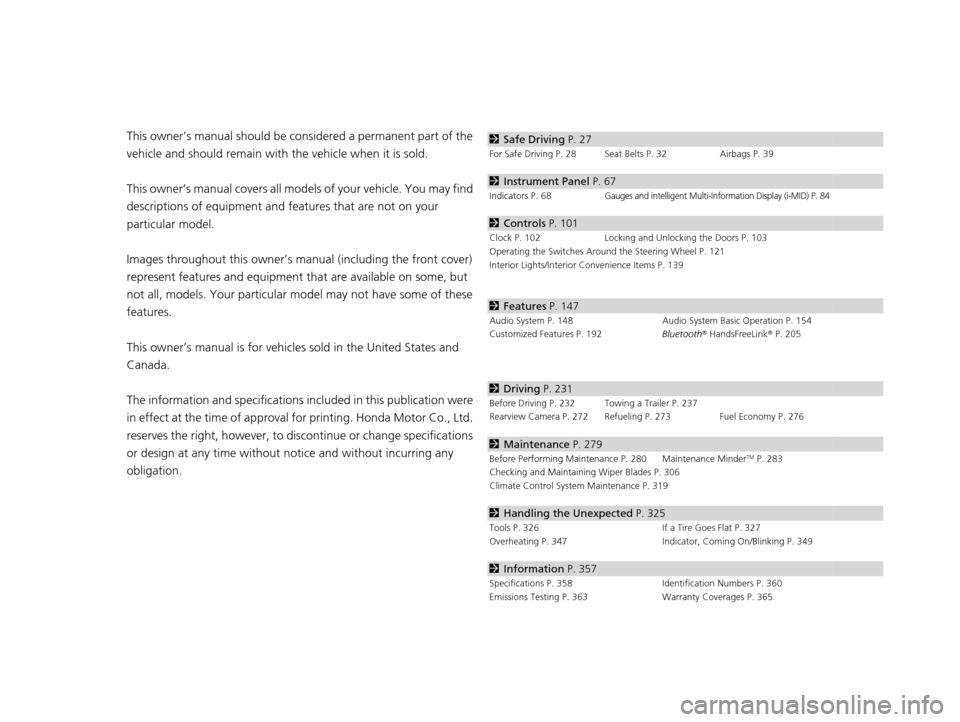
Contents
This owner’s manual should be considered a permanent part of the
vehicle and should remain with the vehicle when it is sold.
This owner’s manual covers all models of your vehicle. You may find
descriptions of equipment and features that are not on your
particular model.
Images throughout this owner’s manual (including the front cover)
represent features and equipment that are available on some, but
not all, models. Your particular mo del may not have some of these
features.
This owner’s manual is for vehicles sold in the United States and
Canada.
The information and specifications in cluded in this publication were
in effect at the time of approval for printing. Honda Motor Co., Ltd.
reserves the right, however, to discontinue or change specifications
or design at any time without notice and without incurring any
obligation.2 Safe Driving P. 27
For Safe Driving P. 28 Seat Belts P. 32 Airbags P. 39
2Instrument Panel P. 67
Indicators P. 68Gauges and intelligent Multi-Information Display (i-MID) P. 84
2Controls P. 101
Clock P. 102 Locking and Unlocking the Doors P. 103
Operating the Switches Around the Steering Wheel P. 121
Interior Lights/Interior Convenience Items P. 139
2 Features P. 147
Audio System P. 148 Audio System Basic Operation P. 154
Customized Features P. 192 Bluetooth® HandsFreeLink ® P. 205
2 Driving P. 231
Before Driving P. 232 Towing a Trailer P. 237
Rearview Camera P. 272 Refueling P. 273 Fuel Economy P. 276
2Maintenance P. 279
Before Performing Maintenance P. 280 Maintenance MinderTM P. 283
Checking and Maintaining Wiper Blades P. 306
Climate Control System Maintenance P. 319
2Handling the Unexpected P. 325
Tools P. 326 If a Tire Goes Flat P. 327
Overheating P. 347 Indicator, Coming On/Blinking P. 349
2Information P. 357
Specifications P. 358 Identification Numbers P. 360
Emissions Testing P. 363 Warranty Coverages P. 365
14 CIVIC IMA-31TR26200.book 0 ページ 2013年12月23日 月曜日 午後4時9分
Page 2 of 377
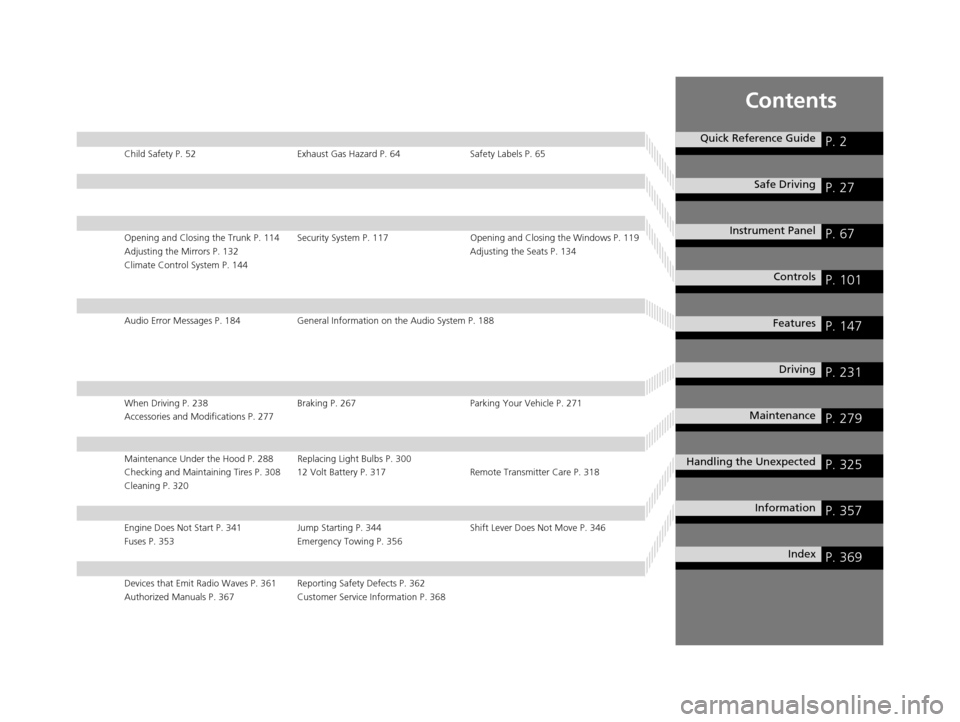
Contents
Child Safety P. 52Exhaust Gas Hazard P. 64Safety Labels P. 65
Opening and Closing the Trunk P. 114 Security System P. 117 Opening and Closing the Windows P. 119
Adjusting the Mirrors P. 132 Adjusting the Seats P. 134
Climate Control System P. 144
Audio Error Messages P. 184 General Information on the Audio System P. 188
When Driving P. 238 Braking P. 267Parking Your Vehicle P. 271
Accessories and Modifications P. 277
Maintenance Under the Hood P. 288 Replacing Light Bulbs P. 300
Checking and Maintaining Tires P. 308 12 Volt Battery P. 317 Remote Transmitter Care P. 318
Cleaning P. 320
Engine Does Not Start P. 341 Jump Starting P. 344 Shift Lever Does Not Move P. 346
Fuses P. 353 Emergency Towing P. 356
Devices that Emit Radio Waves P. 361 Reporting Safety Defects P. 362
Authorized Manuals P. 367 Customer Service Information P. 368
Quick Reference GuideP. 2
Safe DrivingP. 27
Instrument PanelP. 67
ControlsP. 101
FeaturesP. 147
DrivingP. 231
MaintenanceP. 279
Handling the UnexpectedP. 325
InformationP. 357
IndexP. 369
14 CIVIC IMA-31TR26200.book 1 ページ 2013年12月23日 月曜日 午後4時9分
Page 22 of 377
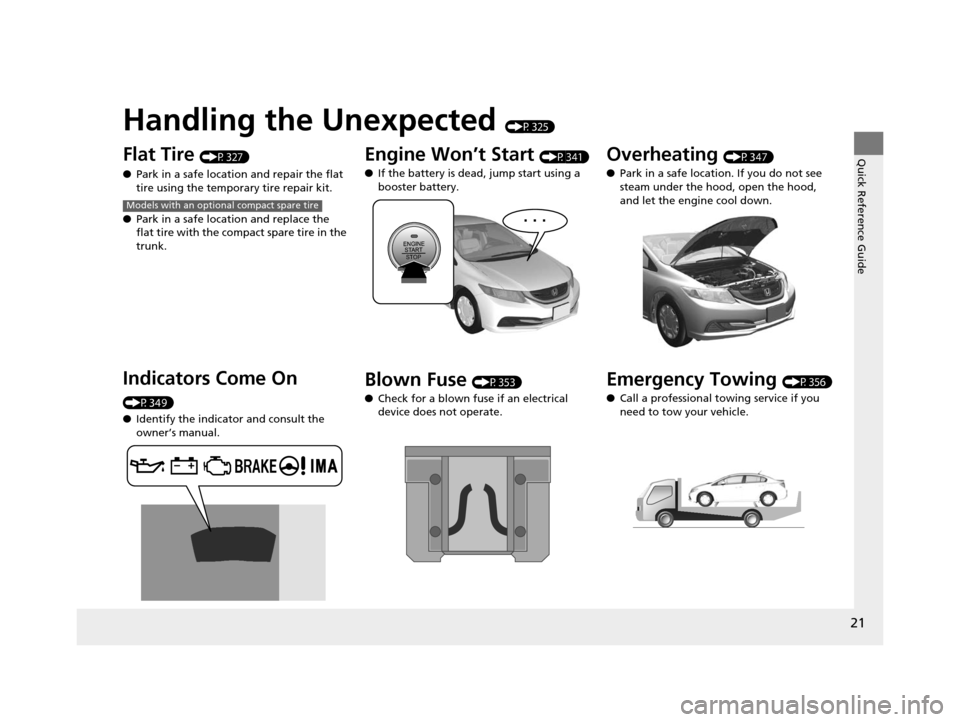
Quick Reference Guide
21
Handling the Unexpected (P325)
Flat Tire (P327)
● Park in a safe location and repair the flat
tire using the temporary tire repair kit.
● Park in a safe location and replace the
flat tire with the comp act spare tire in the
trunk.
Indicators Come On
(P349)
● Identify the indica tor and consult the
owner’s manual.
Models with an optional compact spare tire
Engine Won’t Start (P341)
● If the battery is dead, jump start using a
booster battery.
Blown Fuse (P353)
● Check for a blown fuse if an electrical
device does not operate.
Overheating (P347)
● Park in a safe location. If you do not see
steam under the hood, open the hood,
and let the engine cool down.
Emergency Towing (P356)
● Call a professional towing service if you
need to tow your vehicle.
14 CIVIC IMA-31TR26200.book 21 ページ 2013年12月23日 月曜日 午後4時9分
Page 232 of 377
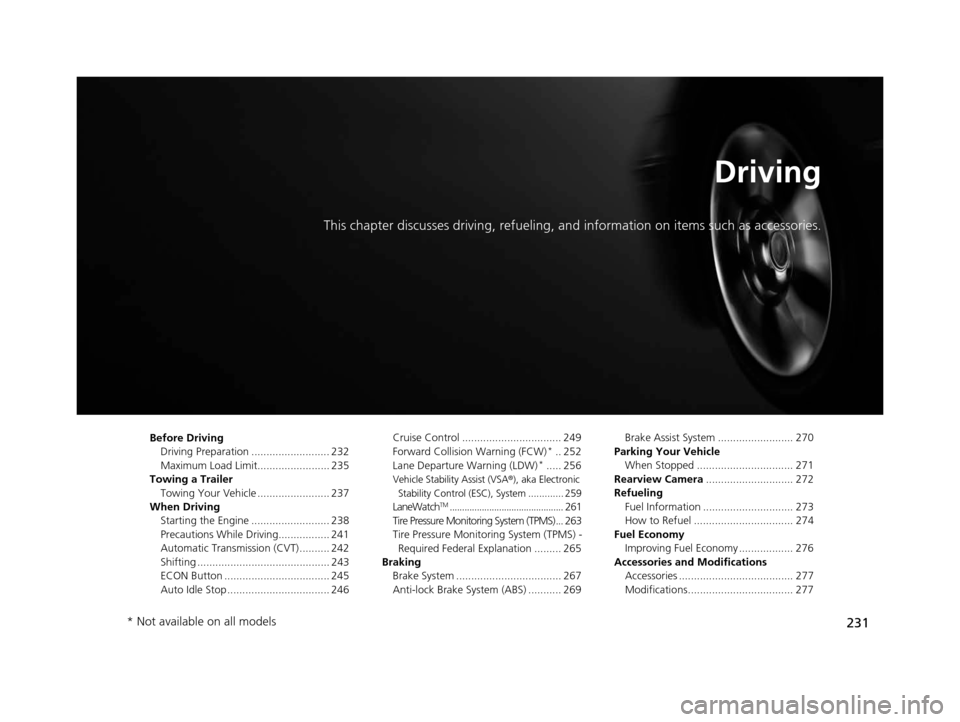
231
Driving
This chapter discusses driving, refueling, and information on items such as accessories.
Before Driving
Driving Preparation .......................... 232
Maximum Load Limit........................ 235
Towing a Trailer Towing Your Vehicle ........................ 237
When Driving Starting the Engine .......................... 238
Precautions While Driving................. 241
Automatic Transmission (CVT) .......... 242
Shifting ............................................ 243
ECON Button ................................... 245
Auto Idle Stop .................................. 246 Cruise Control ................................. 249
Forward Collision Warning (FCW)*.. 252
Lane Departure Warning (LDW)*..... 256
Vehicle Stability Assist (VSA ®), aka Electronic
Stability Control (ESC), System ............. 259
LaneWatchTM.............................................. 261
Tire Pressure Monitori ng System (TPMS) ... 263
Tire Pressure Monitoring System (TPMS) - Required Federal Explanation ......... 265
Braking Brake System ................................... 267
Anti-lock Brake System (ABS) ........... 269 Brake Assist System ......................... 270
Parking Your Vehicle When Stopped ................................ 271
Rearview Camera ............................. 272
Refueling Fuel Information .............................. 273
How to Refuel ................................. 274
Fuel Economy Improving Fuel Economy .................. 276
Accessories and Modifications Accessories ...................................... 277
Modifications................................... 277
* Not available on all models
14 CIVIC IMA-31TR26200.book 231 ページ 2013年12月23日 月曜日 午後4時9分
Page 236 of 377

235
uuBefore Driving uMaximum Load Limit
Continued
Driving
Maximum Load Limit
The maximum load for your ve hicle is 850 lbs (385 kg).
See Tire and Loading Information label attached to the driver’s doorjamb.
This figure includes the total weig ht of all occupants, cargo, and
accessories, and the tongue load if you are towing a trailer.
Steps for Determining Correct Load Limit -
(1) Locate the statement “The comb ined weight of occupants and
cargo should never exceed XXX kg or XXX lbs.” on your
vehicle’s placard.
(2) Determine the combined weight of the driver and passengers
that will be riding in your vehicle.
(3) Subtract the combined weight of the driver and passengers
from XXX kg or XXX lbs.
(4) The resulting figure equals the available amount of cargo and
luggage load capacity. For example, if the “XXX” amount
equals 1,400 lbs. and there will be five 150 lb. passengers in
your vehicle, the am ount of available cargo and luggage load
capacity is 650 lbs.
(1,400 - 750 (5 x 150) = 650 lbs.)1 Maximum Load Limit
Gross Vehicle Weight Rating (GVWR):
The maximum allowable weight of the vehicle, all
occupants, all accesso ries, and all cargo.
2 Specifications P. 358
Gross Axle Weight Rating (GAWR):
The maximum allowable weight of the vehicle axle. 2 Specifications P. 358
3WARNING
Overloading or improper loading
can affect handling and stability
and cause a crash in which you
can be hurt or killed.
Follow all load limits and other
loading guidelines in this manual.Label Example
14 CIVIC IMA-31TR26200.book 235 ページ 2013年12月23日 月曜日 午後4時9分
Page 237 of 377
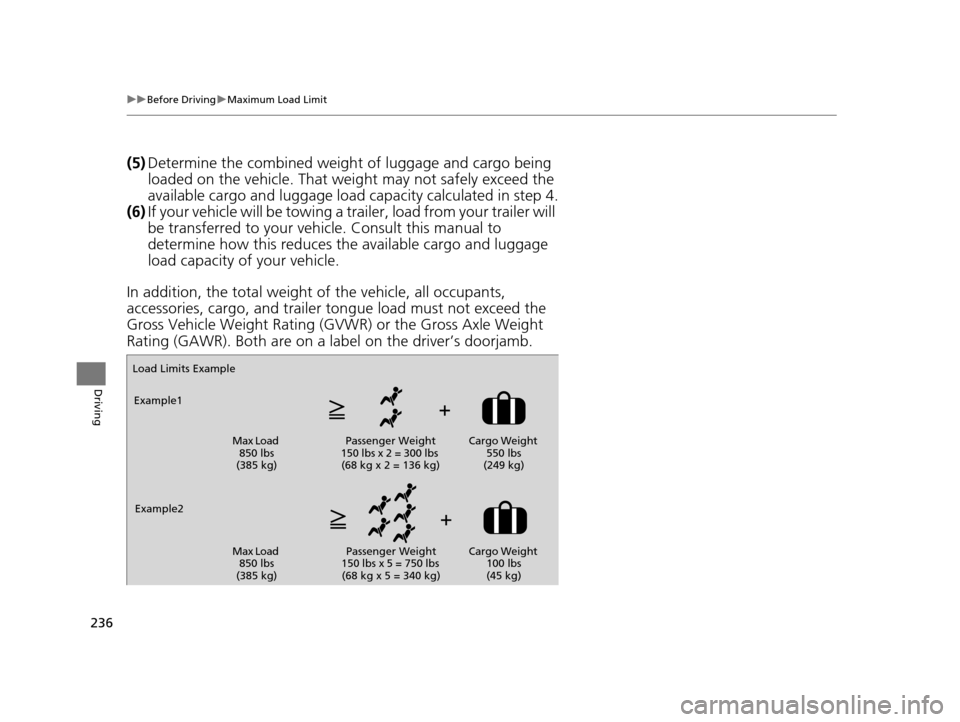
236
uuBefore Driving uMaximum Load Limit
Driving
(5) Determine the combined weight of luggage and cargo being
loaded on the vehicle. That we ight may not safely exceed the
available cargo and luggage load capacity calculated in step 4.
(6) If your vehicle will be towing a tra iler, load from your trailer will
be transferred to your vehicl e. Consult this manual to
determine how this reduces the available cargo and luggage
load capacity of your vehicle.
In addition, the total weight of the vehicle, all occupants,
accessories, cargo, and trailer tongue load must not exceed the
Gross Vehicle Weight Rating (GVW R) or the Gross Axle Weight
Rating (GAWR). Both are on a label on the driver’s doorjamb.
Load Limits Example
Example1
Max Load 850 lbs
(385 kg) Passenger Weight
150 lbs x 2 = 300 lbs (68 kg x 2 = 136 kg) Cargo Weight
550 lbs
(249 kg)
Example2 Max Load 850 lbs
(385 kg) Passenger Weight
150 lbs x 5 = 750 lbs (68 kg x 5 = 340 kg) Cargo Weight
100 lbs
(45 kg)
14 CIVIC IMA-31TR26200.book 236 ページ 2013年12月23日 月曜日 午後4時9分
Page 238 of 377
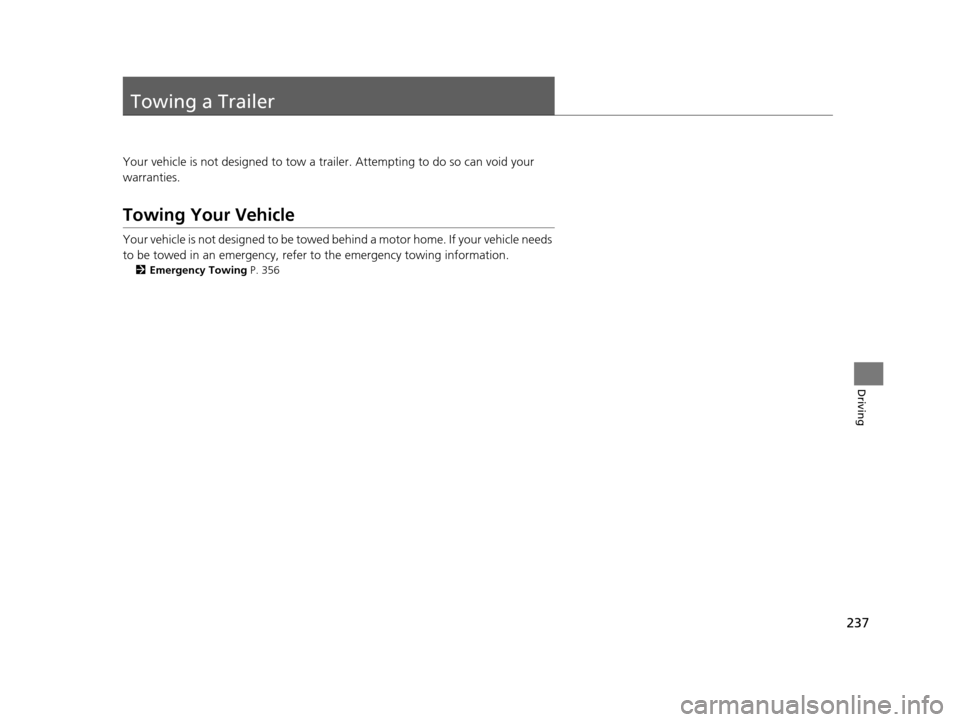
237
Driving
Towing a Trailer
Your vehicle is not designed to tow a trailer. Attempting to do so can void your
warranties.
Towing Your Vehicle
Your vehicle is not designed to be towed behind a motor home. If your vehicle needs
to be towed in an emergency, refer to the emergency towing information.
2Emergency Towing P. 356
14 CIVIC IMA-31TR26200.book 237 ページ 2013年12月23日 月曜日 午後4時9分
Page 264 of 377
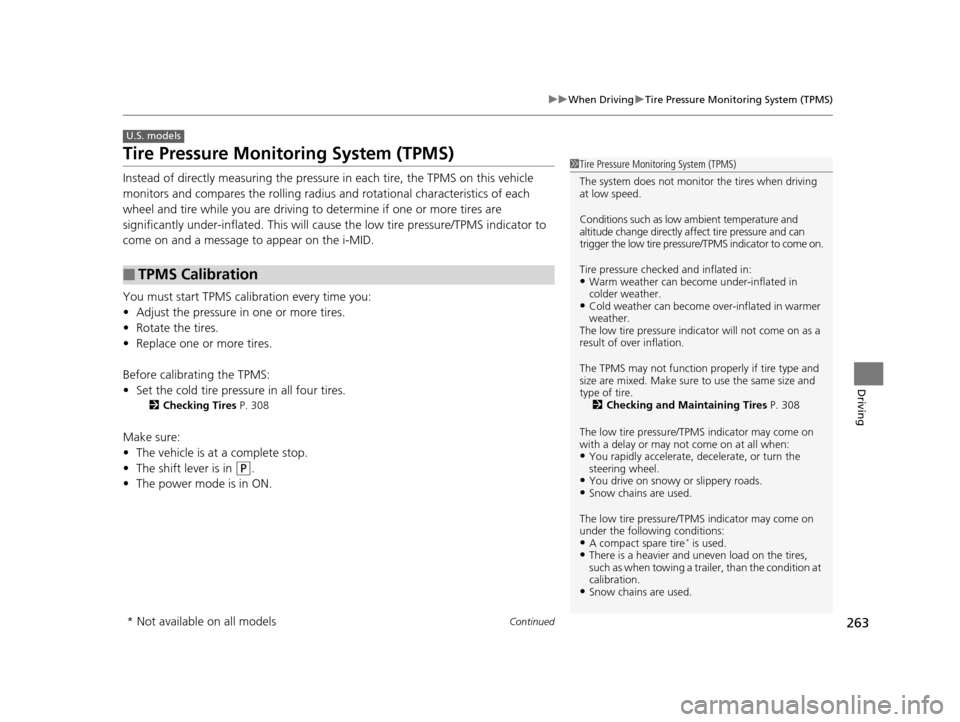
263
uuWhen Driving uTire Pressure Monitoring System (TPMS)
Continued
Driving
Tire Pressure Monitoring System (TPMS)
Instead of directly measuring the pressure in each tire, the TPMS on this vehicle
monitors and compares the rolling radius and rotational characteristics of each
wheel and tire while you are driving to determine if one or more tires are
significantly under-inflated. This will caus e the low tire pressure/TPMS indicator to
come on and a message to appear on the i-MID.
You must start TPMS calibration every time you:
• Adjust the pressure in one or more tires.
• Rotate the tires.
• Replace one or more tires.
Before calibrating the TPMS:
• Set the cold tire pressure in all four tires.
2 Checking Tires P. 308
Make sure:
•The vehicle is at a complete stop.
• The shift lever is in
(P.
• The power mode is in ON.
■TPMS Calibration
U.S. models
1Tire Pressure Monitoring System (TPMS)
The system does not monitor the tires when driving
at low speed.
Conditions such as low ambient temperature and
altitude change directly a ffect tire pressure and can
trigger the low tire pressure/TPMS indicator to come on.
Tire pressure checked and inflated in:
•Warm weather can beco me under-inflated in
colder weather.
•Cold weather can become over-inflated in warmer
weather.
The low tire pressure indica tor will not come on as a
result of over inflation.
The TPMS may not function pr operly if tire type and
size are mixed. Make sure to use the same size and
type of tire. 2 Checking and Maintaining Tires P. 308
The low tire pressure/TPMS indicator may come on
with a delay or may not come on at all when:
•You rapidly accelerate, decelerate, or turn the
steering wheel.
•You drive on snowy or slippery roads.•Snow chains are used.
The low tire pressure/TPMS indicator may come on
under the following conditions:
•A compact spare tire* is used.•There is a heavier and une ven load on the tires,
such as when towing a trailer, than the condition at
calibration.
•Snow chains are used.
* Not available on all models
14 CIVIC IMA-31TR26200.book 263 ページ 2013年12月23日 月曜日 午後4時9分
Page 326 of 377

325
Handling the Unexpected
This chapter explains how to handle unexpected troubles.
ToolsTypes of Tools .................................. 326
If a Tire Goes Flat Temporarily Repairi ng a Flat Tire....... 327
Changing a Flat Tire ......................... 335
Engine Does Not Start Checking the Engine ........................ 341
If the Smart Entry Remote Battery is Weak .......................................... 342
Emergency Engine Stop ................... 343
Jump Starting .................................... 344
Shift Lever Does Not Move .............. 346Overheating
How to Handle Overheating............. 347
Indicator, Coming On/Blinking
If the Low Oil Pressure Indicator Comes On.................................................. 349
If the 12 Volt Battery Charging System
Indicator Comes On ....................... 349
If the Malfunction Indicator Lamp Comes On or Blinks ..................................... 350
If the Brake System Indicator (Red) Comes On...................................................... 351
If the Electric Power Steering (EPS) System Indicator Comes On .............................351
If the IMA Indicator Comes On ........ 352
If the Low Tire Pressure/TPMS Indicator
Comes On or Blinks ....................... 352
Fuses Fuse Locations ................................. 353
Inspecting and Changing Fuses ........ 355
Emergency Towing ........................... 356
14 CIVIC IMA-31TR26200.book 325 ページ 2013年12月23日 月曜日 午後4時9分
Page 333 of 377

uuIf a Tire Goes Flat uTemporarily Repairing a Flat Tire
332
Handling the Unexpected
4. Attach the air only hose onto the tire valve
stem. Screw it until it is tight.
5. Turn the selector switch to AIR ONLY.
u Do not turn the air compressor on to
check the pressure.
2 Inflating an Under-inflated Tire
P. 333
6. If the air pressure is:
• Less than 19 psi (130 kPa):
Do not add air or continue driving. Th e leak is too severe. Call for help and
have your vehicle towed.
2 Emergency Towing P. 356
•32 psi (220 kPa) or more:
Continue driving for another 10 minutes or until you reach the nearest service
station. Do not exceed 50 mph (80 km/h).
u If the air does not go down after the 10 minute driving, you do not need to
check the pressure any more.
• Greater than 19 psi (130 kPa), but less than 32 psi (220 kPa):
Turn the air compressor on to inflate the tire until the tire pressure reaches 32
psi (220 kPa).
Then drive carefully for 10 more minutes or until you reach the nearest service
station. Do not exceed 50 mph (80 km/h).
u You should repeat this procedure as lo ng as the air pressure is within this
range.
7. Press the pressure relief button until the gauge returns to 0 psi (0 kPa).
8. Repackage and properly stow the kit.
1Distributing the Sealant in the Tire
3WARNING
Running the engine with the vehicle in an
enclosed or even partly enclosed area can
cause a rapid build-up of toxic carbon
monoxide.
Breathing this colorless, odorless gas can
cause unconsciousness and even death.
Only run the engine to power the air
compressor with th e vehicle outdoors.
Air Only Hose
14 CIVIC IMA-31TR26200.book 332 ページ 2013年12月23日 月曜日 午後4時9分